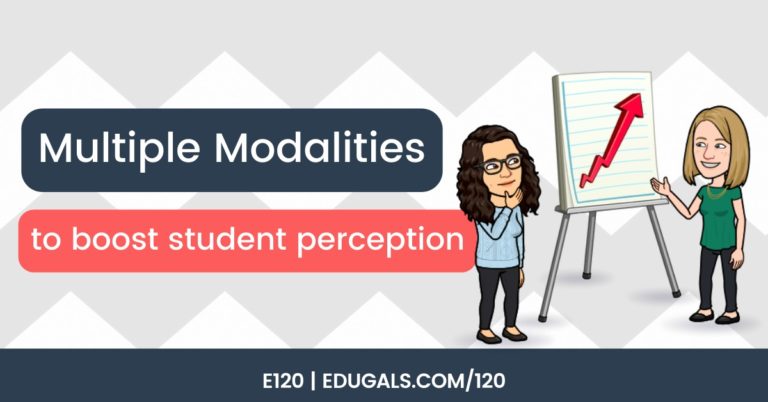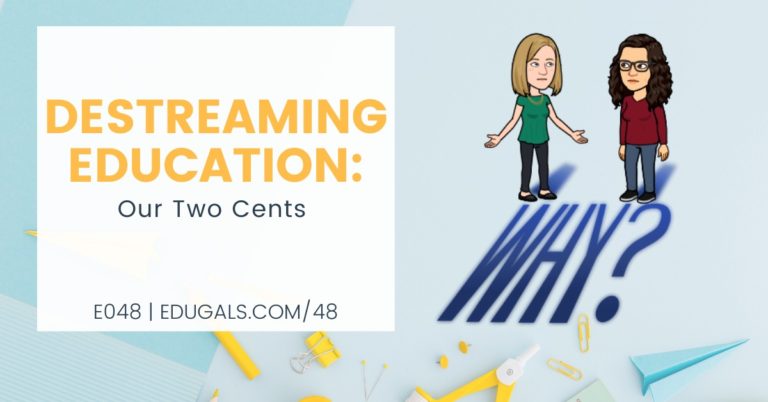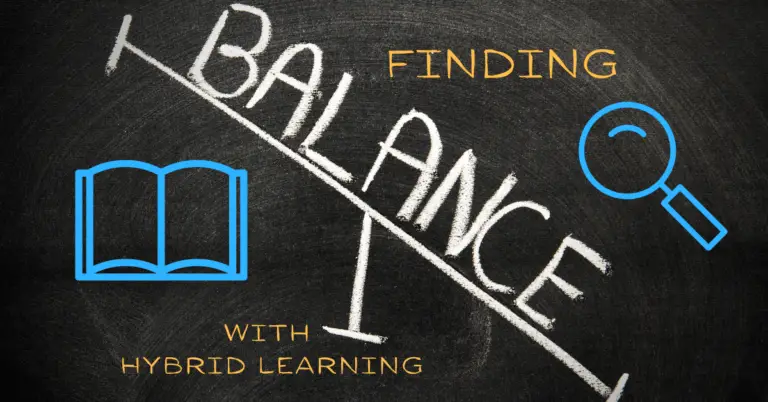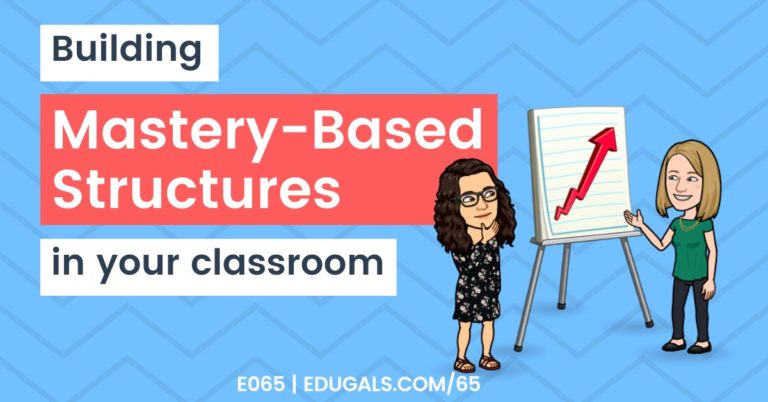[podcast_subscribe id=”7428″]
In this episode, we are talking all about different strategies we can use in our classrooms to make our courses accessible to English Language Learners. We will share some of the different ideas and strategies that we have, and how you can best support these students.
If you like what you hear, we would love it if you could share this episode with a colleague or friend. And make sure you subscribe so that you don’t miss out on any new content! And consider supporting the show by buying us a coffee or two!
We would love to hear from you – leave a comment on our website OR check out our FLIP!
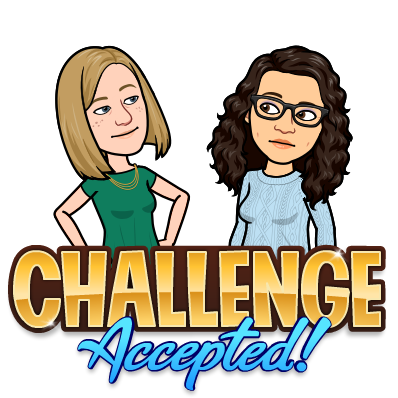
Show Notes
This week, we are chatting all about strategies to make our courses accessible to various English language levels. This is Katie’s area of expertise and passion, as she is the ESL Lead teacher and department head at her school, and she is also pursuing her MEd with a focus on language and literacies education.
In Ontario, we have had an increase in newcomer students who are learning English while attending school. As such, we figured that it was a good idea to. chat about how to support these learners in our classrooms, especially since we will be returning to school next month!
The strategies we will share may have English language learners in mind, but it’s important to note that any strategies or accommodations that you make in your classroom will also end up supporting all of the learners in your course.
It really comes down to a universal design for learning (UDL), and providing scaffolds that will benefit all students and make content accessible to all learners.
Use of Images
It may seem silly or superficial, however images can go a long way in helping students to access the knowledge that they have in their own language(s) and lived experiences, and connecting that to English.
English is a very complex language that has a number of words that mean the same thing, or have a similar definition. For example, the words “building,” “high rise,” and “skyscraper.” Not all of these terms may be familiar to students, but by using an image to accompany a term, it helps students to better understand and visualize what it means, and it makes it easier for them to make sense of content.
Even if you don’t think that a term is significant to the question or problem that students are reading, it’s important to still provide a visual. Students enter our classrooms with a wide range of lived experiences, and it’s important that we don’t assume what words or things students should know.
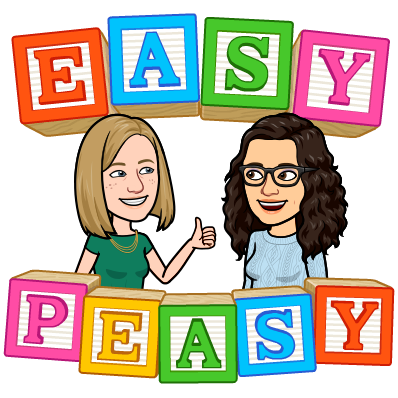
The use of images also helps to reduce the reliance on translators, and helps students make more meaningful connections to what they are reading. It also allows them to interact more with it and ask further questions if the image doesn’t help them to make sense of a term.
There’s a lot of research out there about vocabulary acquisition and the use of images to support students in learning new words, such as the dual coding theory. Images, in addition to the printed and spoken word, are stored differently in our brains, and help students to interact with a language more effectively.
Academic Language vs Basic Interpersonal Communication Skills
When thinking about the language used in the classroom, it’s important to consider what type of vocabulary and language is used. In the ESL world, we often talk about Basic Interpersonal Communication Skills (BICS) and Cognitive Academic Language Proficiency (CALP).
BICS are more social and conversational fluency skills, whereas CALP refers to more academic specific language that needs to be understood and used in class, and is more specific based on the content, such as science, history, etc. It is the academic language that is much more challenging, and requires more time and explicit instruction for students to become more proficient. Interpersonal communication, and the vocabulary required is less challenging, and comes about more naturally through everyday interactions.
It is the academic language that is so important to consider when talking about supporting English language learners and making content accessible to this population of students in particular.
Within academic language, there are terms that we often use in assessments and evaluations, action words that indicate what students are expected to do in a particular situation or scenario. Construct, analyze, determine, prove, evaluate, etc. are examples of the terms that students are likely to come across in an evaluation. As educators, we need to think about how we are helping our students to understand what these terms mean, and what action they require of our students; we also need to ask ourselves how we are explicitly teaching these terms, and ensuring that students know what they mean.
Vocabulary Lists
Vocabulary lists are a great way to let students know what terms they will need to learn and understand in an upcoming unit, but it’s also important to recognize that there are very likely additional terms that you, the educator, may not realize are difficult. These lists can follow whatever model works best for you, such as the Frayer model, a SEE-I model, a more traditional list, etc.
There is no singular profile or lived experience of English language learners. Every single student that walk into our classrooms have different educational experiences, different interests, and in the case of ELLs different language levels. What one student knows in terms of vocabulary may be completely unknown and overwhelming to another student.
As such, while providing a vocabulary list of key terms or phrases is an awesome starting point, keep it open so that students can add additional terms, and consider keeping it open and collaborative so that all students can contribute to the list and share their words with their peers.
Also, make sure you leave room or columns for images, multilingual translations, English definitions, etc. Making these lists a classroom resource, and having students share their individual languages is such a powerful way to include all students, make them feel seen/heard/valued for who they are, and helps to build peer relationships. Some ELLs struggle to feel accepted into their school community, or find that it is difficult to meet others if they are in ESL programming, but by giving students opportunity to share their language(s) in content area classes through something as simple as vocabulary list, it helps students to make these much needed connections with others.
Vocabulary lists are a great start, but it’s also important to give students opportunities to interact with their new language as well. If the sole exposure and interaction is through a list, it makes it extremely challenging for students to commit these terms to long term memory. However, by having students engage in conversations, write using these new terms, etc. it is far more likely that students will be able to acquire content specific vocabulary more effectively.
Tools for Vocabulary
Read&Write Extension
Read&Write by TextHelp is an amazing Chrome extension that is perfect for English language learners, or all learners to be honest. It has a dictionary, a picture dictionary, translation tool, text to voice, voice to text, etc. and it interacts well with Google Docs and Slides.
Evaluation Terminology Dual Language Placemat
An additional tool to consider is creating or finding a dual/single language placemat that provides common evaluation terms, an image to explain that term, and also a translation.
Prior to covid, Katie was working on a project to create these dual language placemats in the most common languages in the Board. The one side would have the English and a translation, and the other side would only have the English term. The idea was that students would use the dual language side until they were more confident with the terminology, and then they’d flip it to English and image only, with the next step being that they wouldn’t need the use of it at all.
As with vocabulary lists, it may also be helpful to have students contribute to these placemats and finding an image that makes sense to them. It could be a great collaborate project to create this helpful classroom resource – and it ends up benefiting all of the students in the classroom!
Asking Questions
Another important area of consideration when teaching ELLs is the way in which we ask questions. Try to avoid simply asking “Do you have any questions?” – depending on the language level of the student this can be an extremely complex question. They may think you are giving them permission to ask to go get a drink, or to go to the bathroom – these are questions!
If you want to know if they understand your lesson, you need to rephrase and add more specific details to guide students and help them understand what you are asking.
You could even flip it slightly to “What questions to do you have about . . . ” or “Do you understand (insert concept)?” By providing more details and making it more clear, students may feel more comfortable sharing what they do or do not understand about a specific lesson or concept.
Mastery Checks & Exit Tickets
A great way to check in to ensure that your students, particularly ELLs, are understanding the lessons is to incorporate some sort of mastery check or exit ticket that has students explaining something, asking specific follow up questions, etc.
How Students Demonstrate Their Learning
English language learners are somewhere along their language journey when they enter your classroom; they could be at the beginning stages of English acquisition; they could be approaching fluency; or somewhere in between those two profiles. With this in mind, we need to be flexible in how we are asking students to demonstrate their learning.
For a newcomer that is just starting to learn English, it isn’t realistic to have them write a full blown lab report or paragraph/essay response. Instead, we need to look at offering options that allow students to show what they know.
As educators, we need to go back to our curriculum, and ask ourselves where in the curriculum it states that a paragraph, essay, etc. are required of students in order to demonstrate their learning. In most content areas, you’ll be surprised (or not) to see that this isn’t an expectation; so why are we still hanging on to these written formats as the expected evaluation format for our students?
If you are insisting on using a paragraph, essay, conversation, etc. – have you explicitly taught these formats and the steps students should take to successfully demonstrate their learning this way in your course? If not, it’s time to start thinking about offering multiple ways, or allowing students to choose the format that they show their learning.
Slides/Images
One way that ELLs can demonstrate their learning is through the use of images and/or slides. Students can show an image and explain what they learned about that concept or process.
Allow L1 Use in the Classroom
Another option to consider, particularly for those just starting their English language journey, is to allow students to use their first language (L1) to explain what they know about that topic. Many of our ELLs have the knowledge, they just lack the English skills to be able to explain and demonstrate it effectively.
When all is said and done, we need to ask ourselves: are we assessing knowledge or language?
Common Scaffolds and Strategies
- Sentence starters
- Word banks
- Fill-in-the-blanks
- Exemplars
- Modelling expected tasks and formats (I do, we do, you do)
- Graphic organizers
- Note-taking (cornell notes, mind maps, dot jots, etc.)
Many times, plagiarism occurs with ELLs because they lack the language skills to be able to identify, simplify, and restate concepts in their own words. Many of the above scaffolds and strategies allow students to develop the skills and language that they need to be successful. As a result, plagiarism will decrease – however we need to take the time to explicitly teach students these skills!
The idea with many of the above scaffolds is that you pull back these scaffolds as the skills and language skills develop. The idea is to provide the support while needed, and work students toward independence and developing these skills.
There are so many cultural considerations to keep in mind as we approach education. Our students come from a wide range of educational experiences, and different cultures approach education differently.
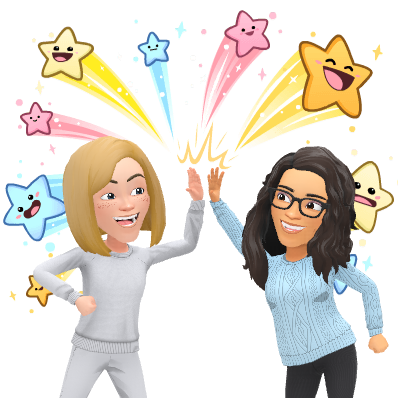
We need to keep all of this in mind, and we need to avoid generalizations and assumptions based on our own lived experiences. Take time – build relationships, develop cultural awareness and critical consciousness, and try to be aware of potential triggering language, events, etc. for students that have experienced or are experiencing trauma.
